Note from the PoolDawg Staff: We’re so excited to partner with Florian “Venom” Kohler on his Venom Trickshots Tutorials video series! Below is a transcript of the first video from this series. Enjoy!
Hi my name is Florian Kohler also known as Venom. Today I wanted to introduce you a new a tutorial series covering the basics of pool. Joining me here is Jamillette. And for the first lesson we're going to go over how to play pool properly. So my opinion to play proper pool you need three major things. A good bridge a solid stance and a very good stroke.
How To Make A Proper Pool Bridge
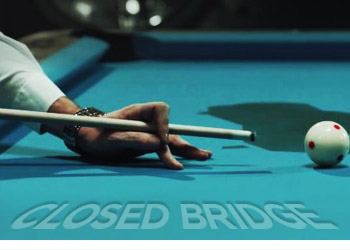
Closed Bridge
The first probably the most important one is your bridge hand. So there's a couple of different bridge. We've got a closed bridge that's number one. So what happens with a closed bridge you put your palm on the table kind of spread your fingers and so the thumb the second finger and the index are going to be all together. They're going to touch at some point and you're going to circle the cue. So it's not necessarily the easiest one to learn but once you have it, it's a pretty solid bridge and you can put a lot of spin but will go together in the next lesson on that.
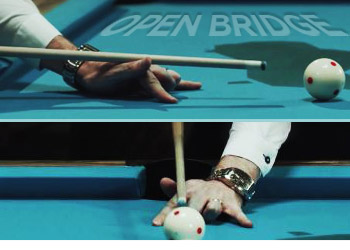
Open bridge allows for a smooth, stable stroke.
Open Bridge
The other option would be an open bridge. So open bridge is a little easier to teach. So what happened here. You're going to put your whole palm on the table. The one I use most commonly for beginners is what I call the spider bridge so kind of doing like this Spiderman sign, put two fingers here a two middle ones here and spread around and then put your thumb up like that. And you know once this is on the table it's a very stable bridge and you can see the cue just groove right into in between your thumb and the top of your hand right here. So this is very solid and very easy to do.
Now there's several different variations in all those so you can you know close your bridge high up or lower and then you can do you know a lot of things like that and the open bridge, same thing you can put your fingers on the table, close it there or even higher up. We'll go into details you know over the next few lessons but mainly what he got to do right now is open bridge closed bridge. So that's every time you're in the middle of the table. Now when are you going to go and your cueball is on the rail. That's going to be more of a problem.
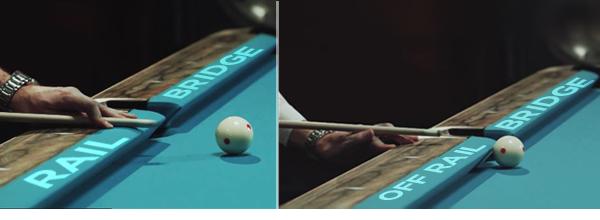
A rail bridge is useful when the cue ball is just off the rail or frozen to the rail.
Rail Bridge
So if you're a little bit off the rail the first rail bridge how I call it is very easy to do you put the cue down these two fingers here put the thumb inside and kind of just you know wrap it around I'm going to go here so you can see so just like that. So this is very stable. It works great sometimes better than if you have an open bridge or close bridge in the middle of the table and then you have probably the most difficult one it's also a rail bridge, but when the ball is frozen to the rail. So I'm going to do my bridge here. So this is an open bridge and I'm going to use, but I'm going to rest the fingers on the side of the table like that. It takes a little getting used to it but it's also a very solid bridge once you get used to it. So there would be you know would you really needs to start getting into pool.
 Frank Says: "Working on your stroke is so important, and the Stroke Groover can really help! It’s a great training aid that’s easy to use!"
Frank Says: "Working on your stroke is so important, and the Stroke Groover can really help! It’s a great training aid that’s easy to use!"
How To Create The Proper Pool Stance
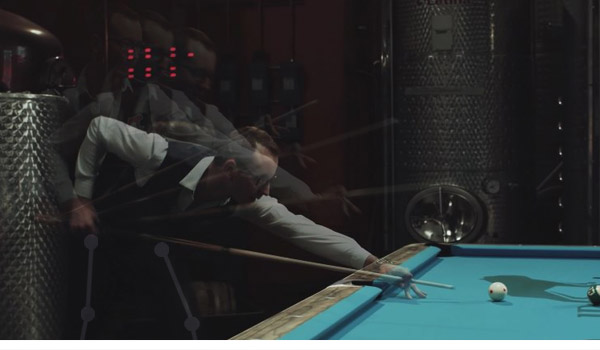
The Proper Stance
Now the next thing really is your stance. It's actually pretty easy. So the number one thing to do is you're going to back up from the table a little bit. So let's say you have a couple of feet away from the table and you're going to kind of line up your shot before you even go into position. So you're here and then I'm going to put my left foot here and I'm stepping into the shot and that is naturally your position. So to sum this one up you're going to have your front foot a little bit bent, little flex there and it's going to be at an angle and some people have more or less of an angle, it's not a major deal. The big deal is probably have this leg that's kind of straight with the foot parallel to the table. Approximately right. In this case of course you if you're in an angle it can't be parallel to the table, but in this case since we're straight's it's about as perfect as it gets. So I'm going to do it again. Come into the shot, bend in just like that. Alright so this is the proper stance. Cue on the side you don't want to do that so you don't want to put your feet together that is uncomfortable. You don't want to do this leg up and bend the other one it's also uncomfortable. I can't do it. There's a few things like that. And also you never want to be like this.
I mean as much as you know it looks normal Sometimes it is very difficult because this leg is going to go in your way and you're going to hit it with your hand. It's something you want to avoid as much as possible. So again you come from step behind step into the shot down there. Now that you're there a few things you gotta think of is your head, too. So you can stay approximately here which is pretty good, but you can go lower if you can. So if you go lower you're going to use your chin as a guide too. And that's pretty good. But of course if it hurts or if it's not comfortable for you depending how tall you are you're going to go up and more. It's no big deal. Your left arm should be you know approximately the way it is here.
I mean you can have it pretty straight but it's not you know it's not comfortable. So you just want to have a little bend in it, not too much bend because that's not comfortable same way. So you just you know kind of find your way find where you're comfortable once you've got all that.
Now the most important part is going to be your stroke. Every pool cue has a grip. So this is basically where you're supposed to hold the cue. So if you go into cue you're going to look for the balance point which is about right here right. So if you were to hold the cue with the balance point right here you cue would just kind of...it would be not comfortable. So basically you're going to go into here and to there and that would be for most of the shots where your hand is going to be. Now if you have a long shot for example you're going to put your back hand a little bit further.
How To Perform The Proper Billiards Stroke
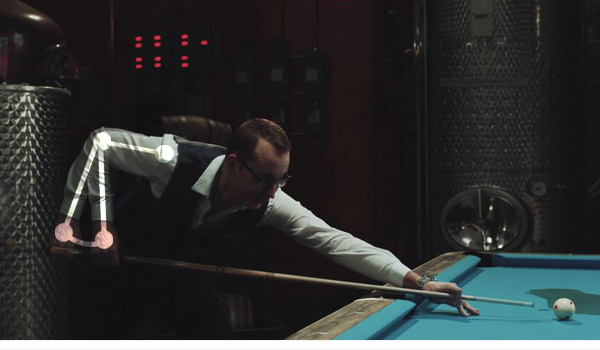
Hand Grip: A loose grip reduces your chances of a miscue in the event of excess arm movement.
Proper Stroke
It's going to help you to aim a little more. But really you really don't want to be too close because that is not good for you. Now once you get that next big mistake for people who don't really know how to play pool is they have a tendency to really grab the cue really tight and hold it and try make sure it doesn't go away. It is not the point. So what you want to do is have a very loose grip and I really use two maybe three fingers to hold the whole cue the entire thing. So you can look at it. When I shoot it's all I'm going to do and if these fingers you can see they're here they're never entirely grabbing the cue because you're going to grab the cue whenever you're going to stroke it you're going to turn it one way or another and you're going to miss the ball so you really don't want that so try to limit as much as possible.
The last big thing is basically your stroke so the pendulum in the arm and the shoulder. So what happened here is you want your wrist in line with your elbow. So kind of like that right. So you don't want to do that too much because it's not comfortable. You don't want to do that because it's going to make you miss. You kinda want to be straight as much as possible. This in line and the next thing is people always think you really have to use your shoulder a lot and that is not what you want to do you want to try to be as stable as straight as possible. So you're going to try to move as much as possible just the elbow. It's okay to move the shoulder a little bit. But you don't want to have too much movement because it's going to cause you to miss. So now that I explained all that. We're going to go over a couple of drills that you could do from home or from your pool hall and just test yourself.
Drills To Help You Perfect Your Stroke
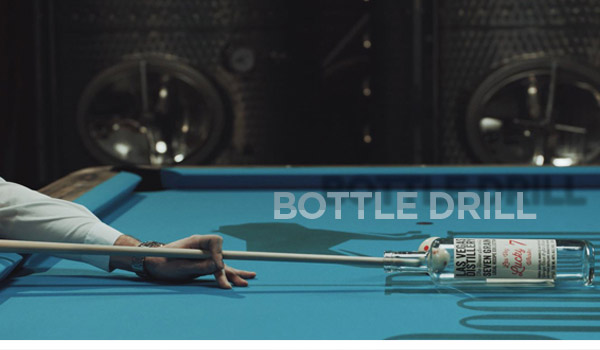
Focus on all aspects of your shot when prefoming the Bottle Drill - Bridge, Stance, and Stroke
Drill One: Bottle Drill
Okay, so the number one drill for me that when I really started to learn pool to just straight was the bottle test. It's very classic. You know it looks easy to just shoot a ball straight like that. But once you get into details you know it's a little harder than you think. So what you're going to do is grab a bottle. It's basically a normal bottle you know you can find anywhere. Just make sure it's slightly bigger than the tip of your cue so my tip here is 13 millimeters so it's slightly bigger. And what you're going to do is you're going to put yourself in the position in your good stroke and your good stance and you want to go put your tip inside the bottle just like that. Right. And you're going to go back and forth practice stroke practice stoke practice stroke. I'm going to try to go further just like that. Still pretty good. I'm going to try further. You can hear it I just touched it and lets try to really go far. There we go. And that's when it's getting really hard. But once you managed that, that means you're basically you're whole stroke is in line that means your shoulder is in line. That means you know everything is basically working for you. And if you do that a little bit it doesn't take very long, you're going to get a lot more confidence in your stroke.
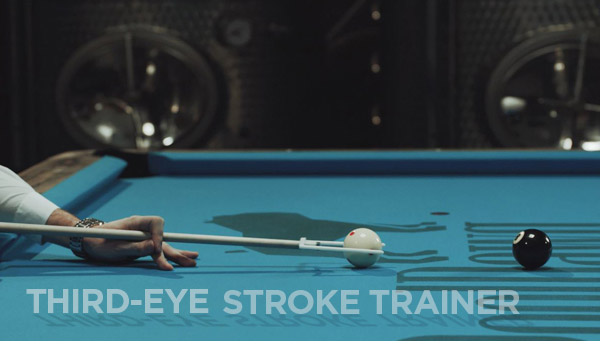
The Third Eye Stroke Trainer is extremely good at correcting excess "wrist roll" in your stroke
Drill Two: Third Eye Stroke Trainer
Now the next drill I have. So you're going to have to buy a little item. It's a pretty cheap item you can find on Pooldawg. It's what we call the Third Eye Stroke Trainer so you just clip it to your cue like that. Right and I want to grab a ball right here. So basically it's almost the same thing. So the only difference is this one is going to give you the lateral damage, too. So you're going to try to go inside you know the ball. Just like that right.
And now you've got this little weight here. And you know if you do something wrong in your wrist it's going to move a little bit like that. So I'm going to try to do a good shot. Right. So that's pretty good. It stays pretty in line. And now let's try to do you know exaggerate a little bit the mistake. So let's say I'm going to do this and you know this happens. It's obviously exaggerated which is why I missed the ball and everything but. This little device here if you stay straight in and when you shoot it stays straight in that means you're pretty good. And of course you don't hit the edge. Perfect.
So in my opinion these two drills are really important to master a good stance a good stroke and a bridge when you start. And if you can manage that we can go to the next level. Alright guys so that's pretty much it for the basics I hope you can practice. Thanks for watching.
- RELATED ARTICLES
- The Perfect Pendulum Stroke – by Samm Diep
- Pool Etiquette: 5 Ways to Avoid Being “That Guy” – by Mikey Verkruyse
- 6 Tips for Mastering the Mechanical Bridge – by Jennifer Barretta